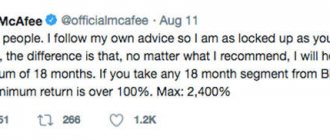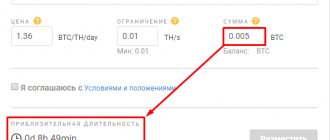The technical indicator Average True Range (ATR) is an indicator of market volatility.
It was introduced by Wells Wilder in the book “New Concepts in Technical Trading Systems” and since then the indicator has been used as a component of many other indicators and trading systems. This is a fairly popular indicator included in most market analysis programs. Its main purpose is to set the correct Stop Loss levels. This is the most effective method of setting stops, which is proven by statistics. Average True Range also serves as a trend filter. It can be interpreted according to the same rules as other volatility indicators. The principle of forecasting using ATR is formulated as follows: the higher the indicator value, the higher the probability of a trend change; the lower its value, the weaker the direction of the trend. A detailed review of the indicator in today's material.
How to use the ATR indicator
Calculation
True Range is the largest of the following three values:
the difference between the current maximum and minimum; the difference between the previous closing price and the current maximum; the difference between the previous closing price and the current low.
True Range = Max(High[1]-Low[1]; High[1] – Close[2]; Close[2]-Low[1])
The Average True Range indicator is a moving average of true range values:
Average True Range = SMA(TR,N), where TR is the true range, N is the averaging period, SMA is the simple moving average.
Among the settings for the ATR indicator, only the averaging period is available, which by default is 14.
Setting Average True Range
Just one unfortunate setup. As usual, to open it, you need to click on the gear icon.
The Inputs menu will open, in which the value of 14 days can be changed to any other.
I wouldn’t touch the value 14 unless absolutely necessary - it does its job well.
In the Style menu you can change the appearance of the line, its thickness and other characteristics.
Using ATR as a filter
ATR can be used as a trend filter. To do this, you need to draw a midline on the ATR chart. When it breaks out, the most significant price movements occur. The indicator does not and cannot have negative values and a certain median line too. It is selected by eye, for each market separately. I advise you to apply a moving average with a long period to the ATR chart as a median line. As long as the ATR is below its moving average, movements are insignificant and the market is calm. When ATR breaks through its average from bottom to top, a trend begins. In addition, some traders recommend using the indicator on several timeframes, for example, on H1 and D1. If their directions are consistent and the indicator crosses its midline on the smaller TF, the market has perked up. Once again, you need to configure the ATR and median line for each market and each TF separately.
ATR14 and MA100 work well as a median line for determining the timing of trading using trading systems based on the principle of mean reversion. The Envelopes indicator (240) applied to the values of the ATR indicator also performs very well - when ATR is below Envelopes, volatility is low, and after the channel breaks upward, sharp volatile movements are possible. ATR is also often used to determine the average length of a candle. For example, if the current ATR reading is greater than, say, 20, or, conversely, less than 10, the trade entry is skipped. Everything here is quite logical - if the candles in the current market are too small, then the potential for profit is small. If the candles are too large, then most likely some extreme events are happening in the market, such as the release of important economic news. And as we all know, during news releases the market is quite unstable and the further direction of the instrument’s movement is poorly predicted.
ATR and volatility
The ATR indicator can help you place your stop loss to suit current market conditions. This will help you avoid placing too narrow stops during periods of high volatility and placing wider stops during periods of low volatility.
Additionally, the indicator can help you set higher profit goals. For example, if the ATR is relatively high, you may want to consider staying in the trade longer, as increased volatility may result in favorable price movements lasting longer.
The arrows on the ATR indicator indicate moments when volatility values are relatively high. Notice the large volatile candles on the chart during the relevant time periods.
In contrast, when the ATR reading is low, the market is relatively calm as it enters a period of low volatility. The candles are small and the price action is calm, so the EUR/USD is consolidating. When volatility is low, you can use tighter stop loss orders. At the same time, your profit taking targets should also be smaller since the price is not expected to move much.
The ATR indicator can also be used to predict future trends. If you notice that the ATR line is moving steadily higher, then you can assume that volatility is likely to remain high. And for an ATR with a constant downward slope, it indicates a range-constrained market in the near future.
At the same time, you must be prepared to move from low to high volatility or from high to low volatility.
Using ATR to Exit
ATR is often used to set an adaptive stop loss, both fixed and floating (trailing stop). I personally like the idea of setting stops based on volatility and I often use this option for trailing. As a rule, to calculate the required size of a stop order, the indicator value is multiplied by a certain constant, which depends on the theoretical duration of the future transaction. For hourly charts, for example, you can take a constant equal to 2-4. That is, for example, for a transaction on EURUSD with ATR=0.0062 on an hourly clock, we multiply 6.2 by a constant, for example, 3, and our stop is approximately 18 - 19 points.
It is much more convenient (and, I think, it will be quite correct and logical) to use ATR for a trailing stop. In this case, the trailing value is automatically adjusted to the current market volatility. For example, we entered into a trade, accumulated a certain profit on the position, and at a given distance the trawl began to move towards the price. The price, in turn, began a sharp movement in the right direction. At the same time, the trawl is kept at a fairly large distance, giving the market the opportunity to move on. Then the movement ends and the flat begins. ATR falls accordingly and our trail becomes shorter - the stop moves closer to the price. As you know, after periods of a strong trend, a flat occurs, after which the price again begins to move sharply, and not necessarily in our direction. In the event of a reversal after a flat period, we will lose a little - our stop will be pulled quite close to the price. If we continue, the picture will repeat again and again, until our stop order is eventually activated.
Why does a trader need to know ATR?
Why does a trader need to know the average price range (ATR)? It is well known that financial instruments periodically change direction while moving.
To make profitable trades, it is important for a trader to understand in which direction and how long the price movement will continue, as well as after what time a reversal will occur. And often, using technical analysis or trend indicators, it is difficult to unambiguously determine whether the price will continue to rise or reverse.
If you find yourself in a situation where, with the correct technical entry after opening a trade, the price turned against you, the ATR indicator will become an additional tool for you that allows you to find the right solutions at such crossroads. And if he doesn’t answer our question about the direction, then we can find out about the range in a certain direction.
Volatility filter for programmers
And as a bonus for those who know (or are learning) to program, I decided to post my version of a function that prohibits trading during high volatility.
extern bool UseATRFilter = true; extern int ATRPer = 14; extern int EnvPer = 240; input ENUM_MA_METHOD EnvMode = MODE_EMA; extern double EnvDev = 10; bool ATRFilter() { if(!UseATRFilter) return(true); double ATR[500]; for(int i=0;i<=499;i++) { ATR =iATR(_Symbol,PERIOD_M5,ATRPer,i+1); } ArraySetAsSeries(ATR,true); double ATR1=iATR(_Symbol,PERIOD_M5,ATRPer,1); double EnvUp=iEnvelopesOnArray(ATR,0,EnvPer, EnvMode,0,EnvDev,MODE_UPPER,0); if(ATR1
This function returns false if the current volatility in the market is too high for trading, and true if the ATR indicator is under the Envelopes channels. The function really significantly improves the results of advisors that use the principles of working in a channel (at least those in which I tried to use it). In addition, I think it will also be useful for trading systems, for which, on the contrary, a low level of volatility brings losses (but I have not yet tested it in this role).
Details of work and formulas
ATR is classified as an "oscillator" because the performance curve fluctuates between values calculated based on the level of price volatility over a user-selected period. This is not a leading indicator as it does not reveal anything related to price direction. High readings suggest that stops will be wider and entry points will also be present to prevent the market from moving quickly against traders. With a percentage of the ATR value, market players can effectively deal with orders that include proportional levels for currency barter.
RegistrationDemo account
The reference lines follow the movements of the indicator
The indicator can also be used for stocks and binary options, as it is able to show a clear picture of the development of the trend over time. ATR not only provides information about the current state of the market, but is also a tool that can be used to make important trading decisions in real time.
The most common use of the ATR indicator by traders is to use it as a stop loss tool. Essentially, when the ATR is high, traders expect wider price movements and thus set their stop loss to avoid stopping earnings prematurely. On the other hand, traders could use a smaller stop loss when volatility is low, thus reducing their losses.
Simply put, stocks with high volatility have a higher ATR, and stocks with low volatility have a lower ATR. Market professionals can use ATR to enter and exit trades as it is a very useful tool to add to a trading system.
Varieties
Like other popular indicators, ATR has received a number of modifications.
LWMA ATR
LWMA ATR is a smoothed version of the standard ATR.
For the standard indicator that we looked at, the ATR for each of the candles is taken on the time scale, and then their overall average is calculated.
The principle of LWMA ATR is slightly different: indicators for candles that are closer to the current price on the time scale receive a larger coefficient, since they are considered to have a stronger influence on the indicator. Accordingly, data on candles that are located further, at the end of the period, have a lower coefficient, since their influence on the indicator is considered insignificant.
Japanese candlesticks are a common type of chart on stock exchanges that display changes in the prices of assets, including cryptocurrency. Each “candlestick” on the chart consists of a body (its boundaries are the opening and closing prices) and a shadow (its boundaries are the minimum and maximum prices for the same period).
ATR Up and Down
ATR Up and Down is close to the original ATR, but with one amendment:
- standard ATR shows the average minimum and maximum price values for a certain period;
- ATR Up and Down uses the average difference between high and low prices instead of the average high and low prices.
How is it calculated
Calculating ATR consists of several steps:
1. First find the difference between:
- current maximum and minimum price;
- the current minimum price and the closing price of the previous day;
- the previous day's closing price and the current maximum price.
2. Of the three obtained values, the largest is selected, on the basis of which a moving average is then constructed.
Today, there is no need to build ATR charts manually - all calculations for the indicator on exchanges and in popular applications like MetaTrader are performed automatically.
Signals based on the ATR indicator
ATR itself is not used as a trading signal, but it can confirm market entry points.
Traders generally purchase a cryptocurrency when its price declines and then moves above a downward trend line. This already serves as a signal to buy. ATR can be used to confirm a signal. If the ATR also moves above its own resistance line during this period, this indicates a strong upward movement.
A simple example of a long buy signal with ATR:
- Bitcoin price and ATR are declining.
- The price of Bitcoin on the daily chart begins to break sharply above the downward trend line.
- ATR also breaks higher - this confirms the establishment of a new, upward trend.
Using ATR you can also determine how soon a trend change will occur. If the price of an asset has passed more than 70% of the daily ATR, then a reversal should be expected. In other cases, there is a high probability of the current trend continuing.
Application
Most often, ATR is used to correctly set stop loss levels, or more precisely, trailing stops. How it works?
Example with exit from trading:
You have opened a long position. The price meets your expectations and is rising. When prices fall by a certain amount, the trailing stop is triggered and the order is closed. This allows you to simultaneously reduce losses and lock in profits.
For reference:
- Stop loss is an option that allows you to automatically close an order when the price of an asset (cryptocurrency) falls to a certain level. This order is called a stop order.
- Take profit is an option that allows you to automatically close a stop order when cryptocurrency prices rise to a certain level. Take profit can serve as insurance against unsuccessful execution of an order, for example, if the connection is lost. Read more: What are Stop Loss and Take Profit in trading?
- Trailing stop (also known as “trailing stop loss”) is a modification of stop loss, where the threshold price, if it falls to which the order is closed, is set at a certain distance from the current profit. As prices and profits rise, the lower threshold value follows suit.
The ATR, as stated, is often used as a trailing stop. View the current average true range values. Place a stop loss that is a multiple of the indicator. Typically a stop loss of 2xATR is set.
This means that the stop loss is 2xATR below the entry price if you buy, or ATR/2 above if you are short.
If you are long and the price movement is upward, the stop loss will follow the price at a distance of 2xATR. In the case of a long position, the stop loss only moves up, not down. Once the stop loss has moved up, it will remain there until the next up move, or until prices fall to the trailing stop, after which the trade will be closed.
The same pattern works for a short, only the stop loss is moved down instead of up. Instead of 2xATR distance for a short, ATR/2 is used.
For reference:
- Long is a position in which a trader buys cryptocurrency, expecting it to grow and, accordingly, trying to resell it at a higher price.
- A short is a position in which a trader sells a cryptocurrency in anticipation of its further decline. This allows the trader to gain funds and use them to buy even more digital coins. Read more: What are Short and Long in trading?
Similarly, ATR can be used as a reference not only for stop loss, but also for take profit. In the case of Forex markets, this is done by subtracting the number of pips passed by the price from the ATR value in points. It is recommended to set the take profit slightly below the received figure.
Pips are another concept from Forex. The value of currencies is determined to the fourth decimal place. This sign is called a pip.










